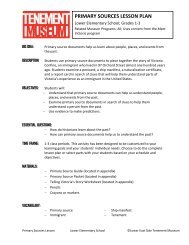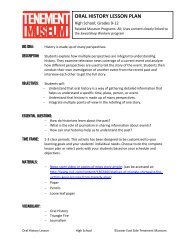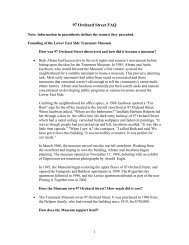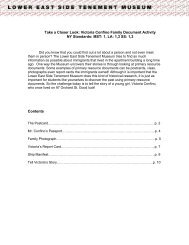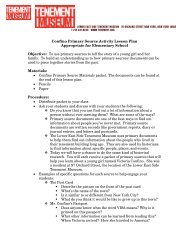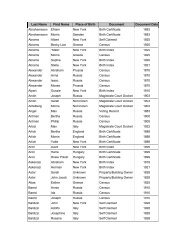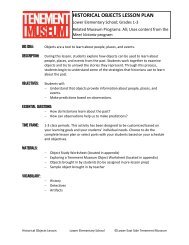primary sources lesson plan - Lower East Side Tenement Museum
primary sources lesson plan - Lower East Side Tenement Museum
primary sources lesson plan - Lower East Side Tenement Museum
- No tags were found...
You also want an ePaper? Increase the reach of your titles
YUMPU automatically turns print PDFs into web optimized ePapers that Google loves.
PRIMARY SOURCES LESSON PLANUpper Elementary School; Grades 4‐5Related <strong>Museum</strong> Programs: All; Uses content from the MeetVictoria programBig Idea:Description:Primary source documents help us learn about people, places, and events fromthe past.Students use <strong>primary</strong> source documents to piece together the story of VictoriaConfino, an immigrant who lived in 97 Orchard Street almost one hundred yearsago. Students examine a variety of <strong>primary</strong> <strong>sources</strong> in order to explore Victoria’simmigrant experience. They use their findings to write a biography of her life.Through this investigation, students learn how <strong>primary</strong> source documents canhelp us understand people, places, and events from the past.Objectives:Students will:− Understand that <strong>primary</strong> source documents can help us understand people,places, and events from the past.− Examine and analyze <strong>primary</strong> source documents in order to learn about aperson from the past.− Learn how to compile research in order to get a more completeunderstanding of the past.Essential Questions:− How do historians learn about the past?− How can <strong>primary</strong> source documents help us to understand the past?Time Frame:Materials:1‐3 class periods. This activity has been designed to be customized to yourlearning goals and your students’ individual needs. Choose to do the complete<strong>lesson</strong> <strong>plan</strong> or select parts with your students based on your schedule andobjectives.− Confino Family Portrait (located in appendix)− Primary Source Guide (located in appendix)− Primary Source Packet (located in appendix)− PencilsVocabulary:− Primary source− Immigrant− Ship manifest−−CensusNaturalizationPrimary Sources Lesson Upper Elementary School ©<strong>Lower</strong> <strong>East</strong> <strong>Side</strong> <strong>Tenement</strong> <strong>Museum</strong>
Procedure:Pre‐Lesson Prep (to be completed by the teacher before the day of the <strong>lesson</strong>)− Review the <strong>primary</strong> source packet and document guide to become familiar with thematerial used in this <strong>lesson</strong>. You can use information from the Document Guide tosupport students’ thinking as they explore the documents. In addition, consider if youwill set up the activity in stations having one <strong>primary</strong> source at each station andstudents circulating through or if students will receive the packet and work in pairs toinvestigate the <strong>sources</strong> and answer the questions and make copies as necessary.Part 1: Introduction− Ask students how other people could learn about them without talking to them.− Encourage students to think about journal entries, pictures, school essays, Facebook,etc.− Facilitate a quick discussion about the challenges of relying on these <strong>sources</strong>. Havestudents consider how accurate a portrayal of them each would offer.− Inform students that when historians try to learn about people, places, and events fromthe past they use <strong>sources</strong> that are as “close” to the person, place, or event as possible.− Inform students that historians would call those <strong>sources</strong> “<strong>primary</strong> source documents.”− Tell students that in today’s <strong>lesson</strong> they will do the work of historians by using <strong>primary</strong>source documents to learn about a person from the past.Part 2: Activity− Display the Confino family portrait. Invite students to examine the photograph andshare their observations. Some guiding questions might include:o What is this?o What can we learn about this family by looking at this photograph?o How might it feel to be one of the people in this picture? How does that help usunderstand what is happening in this portrait?o How can their clothing, expression, and stance inform our interpretation?− Tell students that the photographe was taken in 1913 right after this family immigratedto America.− Explain that class will be using <strong>primary</strong> <strong>sources</strong> to learn about the daughter in thephotograph, Victoria Confino.− Break students up into pairs.− Distribute <strong>primary</strong> <strong>sources</strong>. Depending on your classroom and space set‐up, you can dothis activity as a station exercise, having one source at each station for students toexamine and then having them move through the stations based on your timingdirections. If this is not feasible, you can distribute all the <strong>sources</strong> to the students andhave them work from their seats.Primary Sources Lesson Upper Elementary School ©<strong>Lower</strong> <strong>East</strong> <strong>Side</strong> <strong>Tenement</strong> <strong>Museum</strong>
Confino FamilyPortraitThis portrait was taken right after the Confino family moved to New York Cityin August of 1913. Counterclockwise from right: Abraham (44), Rachel (43),David (9), Victoria (11), Solomon (5), Jacob (3). The clothing proudly worn bythe family members is illustrative of American fashion in the early 20 thcentury and shows how the Confinos transformed their dress from traditionalKastorian garb to the bowler hats and knickers popular in New York.Primary Sources Lesson Upper Elementary School ©<strong>Lower</strong> <strong>East</strong> <strong>Side</strong> <strong>Tenement</strong> <strong>Museum</strong>
Appendix: Primary Source PacketDocument # 1Answer the following questions about this postcard:1. Describe the picture on the front of the postcard.2. What information does the text provide?3. How is it similar to and different from the place in which you live?4. What might it be like to live here?Primary Sources Lesson Upper Elementary School ©<strong>Lower</strong> <strong>East</strong> <strong>Side</strong> <strong>Tenement</strong> <strong>Museum</strong>
Document #2Answer the following questions about this ship manifest:1. What information does this document provide? Considerreferencing a map or globe to find the places listed.2. How did Victoria travel to this country?3. What do you think Victoria’s trip to the United States was like?Primary Sources Lesson Upper Elementary School ©<strong>Lower</strong> <strong>East</strong> <strong>Side</strong> <strong>Tenement</strong> <strong>Museum</strong>
Document #3Answer the following questions about this certificate given toVictoria’s father when he became a United States citizen:1. Who were Victoria’s family members? What can we learnabout Victoria’s family from this document?2. How many brothers and sisters did she have? What were theirnames?3. Describe what it is like having siblings. How does that help usunderstand Victoria?Primary Sources Lesson Upper Elementary School ©<strong>Lower</strong> <strong>East</strong> <strong>Side</strong> <strong>Tenement</strong> <strong>Museum</strong>
Document #4Answer the following questions about Victoria’s report card:1. What information does this document tell us?2. How often did Victoria attend school? How often was she absent?How often was she late?3. In what subjects did Victoria get grades? What were her grades?4. What do her grades tell us about how she was as a student?Primary Sources Lesson Upper Elementary School ©<strong>Lower</strong> <strong>East</strong> <strong>Side</strong> <strong>Tenement</strong> <strong>Museum</strong>
Confino Family PortraitPrimary Sources Lesson Upper Elementary School ©<strong>Lower</strong> <strong>East</strong> <strong>Side</strong> <strong>Tenement</strong> <strong>Museum</strong>



